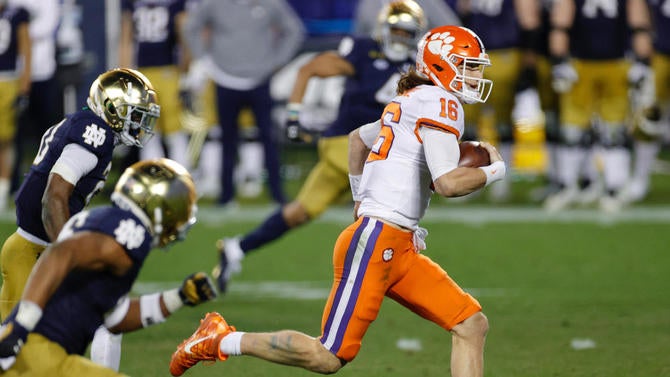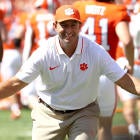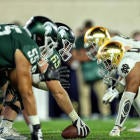
No sport in America has more drawing power than the NFL, and though the behemoth has usually strayed away from competing against college football for television viewership, a pivotal showdown in December may awaken a collaborative partnership or spark a new war for ratings and dollars.
The long-awaited expansion of the College Football Playoff this fall sets the stage for the first-of-its-kind battle on a Saturday afternoon in late December, with games of consequence in both the college and professional leagues scheduled for head-to-head competition on major national television networks: two first-round CFP games on TNT against two NFL matchups on Fox and NBC.
Such a battle has mostly been avoided by the NFL and college football thanks to the Sports Broadcasting Act of 1961, which dictates the NFL avoid televising games from Fridays at 6 p.m. through midnight Sunday starting on the second Friday in September through the second Saturday in December. Outside that window, lower and mid-tier bowl games have pushed against the NFL with little success. The CFP's foray into the NFL schedule provides the stiffest competition yet for the league -- and network executives are anxious to see how it unfolds Dec. 21.
It's also plausible – and expected -- viewership will not be nearly as high had the two organizations scheduled their games on separate dates. History shows the biggest loser will be college football. The NFL has dwarfed the NBA and MLB on head-to-head dates. NFL viewership was 10 times higher than the NBA on Christmas Day last year. The World Series purposefully avoided the NFL's highest-rated television window on Sunday night in 2022 for the first time.
College football, however, is a different animal. If the NFL is the king of sports, college football is at least in the king's court.
"You're going to get a smaller audience than [the CFP] normally would but you can still survive," said Jon Lewis, founder of Sports Media Watch, which analyzes sports television ratings and the sports media industry. "The casuals are going to choose the NFL. You're not going to meaningfully grow your audience against them."
The NFL is not just a TV ratings juggernaut that smothers professional sports, it's a touchstone for casual TV viewers. Ninety-three of the 100 highest-rated television programs in 2023 were NFL games, according to the Sports Business Journal. By comparison, only three college football games ranked in the top 100, with the top event (Ohio State-Michigan) ranking 61st last year with 19.07 million viewers.
And the NFL's regular season continues to grow. The league averaged 17.9 million viewers in the regular season last fall and the playoffs were the most-watched since 1988 with an average of 38.5 million. Only one college football game in the regular season rated higher than the NFL's average: Ohio State-Michigan.
The scheduling decisions by the CFP and NFL on the third Saturday in December are not as much a gamble as it is a litmus test as they forge a new working relationship while balancing cooperation and competition.
"Our playoffs are going to be wildly successful," CFP board chairman Mark Keenum told CBS Sports. "The fans are going to be excited about this new format, the on-campus games are going to be very exciting. It's going to be a whole new exciting era of football."
There are two primary lines of thinking among TV media experts surveyed by CBS Sports.
- College football is poised to grow its audience in an age of channel flipping and multi-screen viewing sparked by the recent flourish of sports betting.
- College football's viewership will not grow substantially, much like the MLB and the NBA have been dwarfed by the NFL in head-to-head competition.
CFP leaders long believed a television showdown with the NFL was inevitable, so the CFP's television committee worked alongside the NFL's leadership to discuss television windows with broadcast partners, sources told CBS Sports. Both parties hoped to avoid as many head-to-head matchups as possible, sources told CBS Sports, and for one year at least, the CFP and NFL avoided same-day showdowns during the CFP's semifinals (Jan. 9-10) and the NFL's Wild Card playoffs (Jan. 11-13). Had the CFP stepped into the NFL's playoff schedule, it likely would have been a ratings disaster for the CFP, industry sources agreed.
The CFP also briefly discussed playing all four of its first-round games on weekdays to avoid the NFL, though that was a non-starter because of fan travel and a desire for more preparation time for teams.
"By prioritizing health and safety, we understood that would place our first-round games on the same Saturday as the NFL, but CFP's games have proven to be highly popular with fans and I anticipate that will continue," said ACC commissioner Jim Phillips, who serves on the CFP's television committee. "The schedules may overlap at times, which means fans will have their pick of games. Given the complexities of our schedule and theirs, it was inevitable."
In the end, the CFP opted to schedule its first round with one game on Friday (ABC/ESPN) and three on Saturday, with TNT handling the afternoon kickoffs (12 p.m. and 4 p.m. ET) and ABC and ESPN simulcasting the evening kickoffs on Friday and Saturday at 8 p.m.. ESPN sub-licensed the Saturday afternoon games to TNT, but financial terms were not disclosed. ESPN declined comment for this story when reached by CBS Sports and TNT did not respond to requests.
"It's a low-risk, high reward for ESPN and you're getting money for the least attractive games," Lewis said.
The NFL has long been seeking new broadcast opportunities as it tests the market's growth. The league expanded its Thanksgiving weekend schedule in 2023 with a game on Black Friday, and last season competed head to head (and avoided that 6 p.m. cut-off outlined in the Sports Broadcasting Act) against college football. Unsurprisingly, the NFL won the ratings battle with 9.61 million viewers compared to 4.09 million for Missouri's blowout of Arkansas on CBS.
The NFL joined the streaming wars in 2017 with Amazon Prime, which streamed its Thursday night games. The league and Netflix earlier this year announced Christmas Day games will be streamed on Netflix this season. Subsequently, the NFL was required to schedule at least two games on Dec. 21 -- Houston Texans at Kansas City Chiefs (1 p.m.) and Baltimore Ravens at Pittsburgh Steelers (4:30 p.m.) -- to accommodate the Christmas schedule, and set up the showdown with the CFP. It is believed the NFL previously discussed scheduling as many as three games on Dec. 21, which would have placed more pressure on the CFP and likely would have further tempered college viewership, but the league opted to scale back to help the CFP, sources told CBS Sports.
"A lot of this is trial and error," said Travis Vogan, a University of Iowa professor who authored several books on network sports television. "We're seeing so much inconsistency with who's carrying games, whether the NFL is trying stuff with Amazon Prime or Netflix. Organizations are adjusting to this new environment still. It's a pretty slow adjustment but I think that's part of what we're seeing here with this matchup."
The NFL isn't standing down, however. The NFL in past seasons scheduled Saturday games in December on the subscription-based NFL Network rather than on major television networks, but opted this year to move those games to Fox and NBC during the CFP. The move might shine a light on a lesson the league learned in 2020, when the coronavirus pandemic led to a delayed schedule for college football and set up the first major showdown against college football's postseason that fell outside the parameters of the Sports Broadcasting Act. Conference championship games were scheduled two weeks beyond their usual dates, and on Dec. 19 the ACC, SEC and Big Ten's conference championship games faced off against two regular-season games on the NFL Network.
College football trounced the NFL.
The ACC Championship between Clemson and Notre Dame pulled 9.92 million viewers in prime time, exceeding the highest-rated NFL game (Green Bay vs. Carolina) by more than 4.3 million viewers.
"I'm not surprised that the NFL, probably still remembering that, is of the mind that they're not losing to college football again," Lewis said. "I don't think it's a coincidence these games are on NBC and Fox, and not NFL Network."

It's difficult to gauge what the CFP should target as a successful debut. Lower-tier bowl games that competed against the NFL near the same calendar date have struggled. Seven bowls on Dec. 23 averaged 1.81 million viewers compared to an average of 10.81 million viewers for two NFL games on the same day last season. The Pop-Tarts Bowl on Dec. 28 sparked interest with its Pop-Tarts mascot and a tight game between Kansas State and NC State, pulling 4.31 million viewers for ESPN, the largest audience for a bowl game up until that date, but the NFL's Thursday night game on Amazon Prime drew an audience of 10.29 million.
The CFP's semifinals on New Year's Day last season averaged 23.27 million viewers without competition from the NFL.
Considering the context of a first-time event and the NFL's presence in prime time, Lewis believes an average of 10 million viewers for the first round would be a strong start for the new CFP.
"You're not going to get playoff-level viewership that we're used to," Lewis said.
There is hope among college leaders the NFL and CFP will continue to work in unison with scheduling rather than view December's showdown as a testing site for future showdowns on network television.
"We should not be cannibalizing each other," a power conference administrator told CBS Sports. "We should be growing the sport together."
One industry source suggested the CFP extending into the NFL's territory could provide the league enough impetus to challenge the Sports Broadcasting Act and schedule games against college football in the regular season.
"It doesn't necessarily matter if the total audience numbers aren't the same as 10 years ago, but just getting that percentage is more valuable nowadays with folks doing more on-demand viewing," Vogan said. "Capturing audiences is harder and harder these days."
















